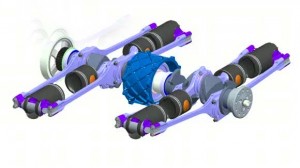There’s so much talk all across the automotive industry about battery electric vehicles, it would seem that the death of the internal combustion engine is imminent.
But even the top proponents of battery power caution that the proven petroleum-powered internal combustion engine, or ICE, will continue to power cars for years to come. So, we might as well work on building a better one.
Long-time Detroit automotive executive Don Runkle presented such a solution at this month’s Green Car Conference. Runkle’s company, EcoMotors International is developing the OPOC – opposed piston opposed cylinder – engine.
The engine is a horizontally opposed design with two pistons running in each cylinder. The two-stroke engine has a power burst for every revolution of the crank in each cylinder instead of every other revolution, as is the case with today’s conventional ICE.
Click Here for a video of Inventor Peter Hofbauer explaining how the engine works.
“It’s a better mousetrap,” Runkle said.
The keys are power density, balance, simplicity and scalability, Runkle said.
- Power density – Because the engine has power strokes twice as often as a conventional engine, a smaller unit can produce similar power. Runkle said the company expects to increase power density four-fold.
- Balance – the engine is inherently balanced because it is horizontally opposed. This will allow engineers to make smoother engines with fewer cylinders.
- Simplicity – A 300-horsepower OPOC engine has 62 moving parts compared to 385 for a conventional engine with similar power. The design eliminates the ICE’s separate head and all of its cams, valves and associated hardware. Fewer parts also means less cost.
- Scalability – The engine can be sized anywhere from 15-horsepower lawn tractor motors up to and beyond 600-horsepower beasts for heavy equipment. Each pair of cylinders can operate independently with electric clutches disconnecting power modules when not needed. This is superior to a regular ICE’s modular displacement system which stops sending fuel to unneeded cylinders, while the engine still has to move the pistons.
A major advantage of the OPOC for automakers is they could start building it immediately without major changes in infrastructure, Runkle said.
“There are no unique processes or machining,” Runkle said.
The bottom line is the engine offers emissions that are on par with today’s engines with 42 percent better efficiency. With 80% fewer moving parts, Runkle said reliability should be superior.
Fifteen original equipment manufacturers have shown an interest in the new engine architecture, he said.
Still, Runkle knows there is a long road ahead before the world’s automakers are ready to turn their backs on the traditional ICE, which the auto industry has continuously improved for more than 100 years. But the Troy, Michigan, and Goleta, California-based company has the backing of venture capitalists and is currently seeking a $207 million loan from the U.S. Department of Energy. (Runkle insists the company’s business plan is not dependent on getting the loan.)
Runkle has some experience in testing a promising, but unproven engine design, the Wankel rotary, which GM and many other automakers worked on in the 1960s and ‘70s. In the end, only Mazda was able to find any success with the rotary and that has been limited by troubles with emissions, fuel economy and durability.
GM later gave serious consideration — as did many of its competitors — to an updated version of the standard two-stroke engine developed by Orbital, an Australian start-up. The firm went so far as to set up a plant in Tecumseh, Michigan, to build the high-mileage engine, but increasingly stringent emissions standards scuttled the venture before it went into production.
Runkle is more upbeat about its new technology, and expects that EcoMotors would mostly license the OPOC technology to automakers since most of them prefer to build their own engines.


That looks really cool and efficient. I hope it succeeds.
There are two problem fields with this concept:
1. Oil emissions because of piston rings passing over the exhaust openings and
2. durability issues because of the comparably high power density achieved. Power density is in itself a good thing, because it cuts on thermal losses, but it’s very much a material problem.
If it works, the mileage would be pretty unbeatable, BUT. . .
So it’s good news, that there will be big development funds.